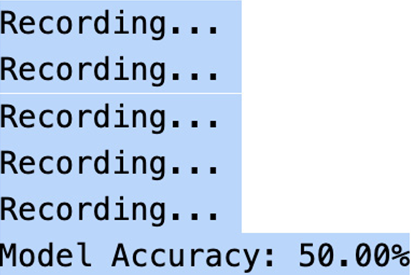Combine and shuffle data: Positive and negative samples are combined into feature vectors (X) and corresponding labels (y). The data is shuffled to ensure a balanced distribution during training:
Combine and shuffle the data
X = np.vstack([positive_X, negative_X])
y = np.concatenate([positive_y, negative_y])
Split data into training and testing sets: The data is split into training and testing sets using the train_test_split function from scikit-learn:
Split the data into training and testing sets
X_train, X_test, y_train, y_test = train_test_split(X, y, \
test_size=0.2, random_state=42)
Train the voice classifier: A VoiceClassifier class is defined, encapsulating the random forest model. An instance of the VoiceClassifier is created, and the model is trained using the positive and negative training data:
Train the voice classifier model
voice_classifier = VoiceClassifier()
voice_classifier.train(X_train, y_train)
Make predictions: The trained model predicts labels for the test set:
Make predictions on the test set
predictions = voice_classifier.predict(X_test)
Evaluate model accuracy: The accuracy of the model is evaluated using scikit-learn’s accuracy_score function, comparing predicted labels with actual labels:
Evaluate the model
accuracy = accuracy_score(y_test, predictions)
print(f”Model Accuracy: {accuracy * 100:.2f}%”)
When you run this code, it prompts with the following pop-up window to enter and speak.

Figure 11.1 – Prompt to start speaking
Then, you speak a few sentences that will be recorded:

Figure 11.2 – Trained model accuracy
Inference: Let’s see the practical application of a pre-trained voice classification model for real-time voice inference. Leveraging the scikit-learn library’s RandomForestClassifier, the model was previously trained to discern between positive samples (voice) and negative samples (non-voice or background noise).
The primary objective of this script is to demonstrate the seamless integration of the pre-trained voice classification model into a real-time voice inference system. You are prompted to provide audio input by pressing Enter and speaking for a few seconds, after which the model predicts whether the input contains human speech or non-voice elements:
import joblib
Save the trained model during training
joblib.dump(voice_classifier, “voice_classifier_model.pkl”)
import numpy as np
import sounddevice as sd
from sklearn.ensemble import RandomForestClassifier
from sklearn.externals import joblib For model persistence
Load the pre-trained model
voice_classifier = joblib.load(“voice_classifier_model.pkl”)
Function to capture real-time audio
def capture_audio(duration=5, sampling_rate=44100):
print(“Recording…”)
audio_data = sd.rec(int(sampling_rate * duration), \
samplerate=sampling_rate, channels=1, dtype=’int16′)
sd.wait()
return audio_data.flatten()
Function to predict voice using the trained model
def predict_voice(audio_sample):
prediction = voice_classifier.predict([audio_sample])
return prediction[0]
Main program for real-time voice classification
def real_time_voice_classification():
while True:
input(“Press Enter and speak for a few seconds…”)
Capture new audio
new_audio_sample = capture_audio()
Predict if it’s voice or non-voice
result = predict_voice(new_audio_sample)
if result == 1:
print(“Voice detected!”)
else:
print(“Non-voice detected.”)
if __name__ == “__main__”:
real_time_voice_classification()
The output is as follows:

Figure 11.3 – Inference output
In a similar manner, we can use this model to label a voice as male or female to analyze customer calls and understand target customers.
We have seen the real-time voice classification inference that holds significant relevance in numerous scenarios, including voice-activated applications, security systems, and communication devices. By loading a pre-trained model, users can experience the instantaneous and accurate classification of voice in real-world situations.
Whether applied to enhance accessibility features, automate voice commands, or implement voice-based security protocols, this script serves as a practical example of deploying machine learning models for voice classification in real-time scenarios. As technology continues to advance, the seamless integration of voice inference models contributes to the evolution of user-friendly and responsive applications across various domains.
Now, let’s see how to transcribe audio using the OpenAI Whisper model.